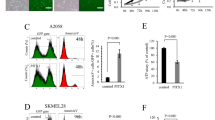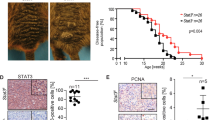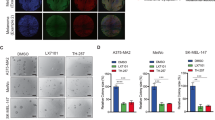Abstract
Promyelocytic leukemia zinc-finger (PLZF) is a transcriptional repressor and tumor suppressor. PLZF is expressed in melanocytes but not in melanoma cells, and recovery of PLZF expression markedly suppresses melanoma cell growth. Several target genes regulated by PLZF have been identified, but the precise function of PLZF remains uncertain. Here, we searched for candidate target genes of PLZF by DNA microarray analysis. Pre-B-cell leukemia transcription factor 1 (Pbx1) was one of the prominently suppressed genes. Pbx1 was highly expressed in melanoma cells, and its expression was reduced by transduction with the PLZF gene. Moreover, the growth suppression mediated by PLZF was reversed by enforced expression of Pbx1. Knockdown of Pbx1 by specific small interfering RNAs suppressed melanoma cell growth. We also found that Pbx1 binds HoxB7. Reverse transcription–polymerase chain reaction analysis demonstrated that repression of Pbx1 by PLZF reduces the expression of HoxB7 target genes, including tumor-associated neoangiogenesis factors such as basic fibroblast growth factor, angiopoietin-2 and matrix metalloprotease 9. These findings suggest that deregulation of Pbx1 expression owing to loss of PLZF expression contributes to the progression and/or pathogenesis of melanoma.
This is a preview of subscription content, access via your institution
Access options
Subscribe to this journal
Receive 50 print issues and online access
$259.00 per year
only $5.18 per issue
Buy this article
- Purchase on Springer Link
- Instant access to full article PDF
Prices may be subject to local taxes which are calculated during checkout







Similar content being viewed by others
References
Ahmad SA, Liu W, Jung YD, Fan F, Wilson M, Reinmuth N et al. (2001). The effects of angiopoietin-1 and -2 on tumor growth and angiogenesis in human colon cancer. Cancer Res 61: 1255–1259.
Barna M, Hawe N, Niswander L, Pandolfi PP . (2000). Plzf regulates limb and axial skeletal patterning. Nat Genet 25: 166–172.
Barna M, Merghoub T, Costoya JA, Ruggero D, Branford M, Bergia A et al. (2002). Plzf mediates transcriptional repression of HoxD gene expression through chromatin remodeling. Dev cell 3: 499–510.
Becker D, Meier CB, Herlyn M . (1989). Proliferation of human malignant melanomas is inhibited by antisense oligodeoxynucleotides targeted against basic fibroblast growth factor. EMBO J 8: 3685–3691.
Care A, Silvani A, Meccia E, Mattia G, Stoppacciaro A, Parmiani G et al. (1996). HOXB7 constitutively activates basic fibroblast growth factor in melanomas. Mol Cell Biol 16: 4842–4851.
Care A, Silvani A, Meccia E, Mattia G, Peschle C, Colombo MP . (1998). Transduction of the SkBr3 breast carcinoma cell line with the HOXB7 gene induces bFGF expression, increases cell proliferation and reduces growth factor dependence. Oncogene 16: 3285–3289.
Care A, Felicetti F, Meccia E, Bottero L, Parenza M, Stoppacciaro A et al. (2001). HOXB7: a key factor for tumor-associated angiogenic switch. Cancer Res 61: 6532–6539.
Chang CP, Shen WF, Rozenfeld S, Lawrence HJ, Largman C, Cleary ML . (1995). Pbx proteins display hexapeptide-dependent cooperative DNA binding with a subset of Hox proteins. Genes Dev 9: 663–674.
Chen Z, Brand NJ, Chen A, Chen SJ, Tong JH, Wang ZY et al. (1993). Fusion between a novel Kruppel-like zinc finger gene and the retinoic acid receptor-alpha locus due to a variant t(11;17) translocation associated with acute promyelocytic leukaemia. EMBO J 12: 1161–1167.
Costoya JA, Hobbs RM, Barna M, Cattoretti G, Manova K, Sukhwani M et al. (2004). Essential role of Plzf in maintenance of spermatogonial stem cells. Nat Genet 36: 653–659.
Etoh T, Inoue H, Tanaka S, Barnard GF, Kitano S, Mori M . (2001). Angiopoietin-2 is related to tumor angiogenesis in gastric carcinoma: possible in vivo regulation via induction of proteases. Cancer Res 61: 2145–2153.
Felicetti F, Bottero L, Felli N, Mattia G, Labbaye C, Alvino E et al. (2004). Role of PLZF in melanoma progression. Oncogene 23: 4567–4576.
Goishi K, Higashiyama S, Klagsbrun M, Nakano N, Umata T, Ishikawa M et al. (1995). Phorbol ester induces the rapid processing of cell surface heparin-binding EGF-like growth factor: conversion from juxtacrine to paracrine growth factor activity. Mol Biol Cell 6: 967–980.
Heinemeyer T, Wingender E, Reuter I, Hermjakob H, Kel AE, Kel OV et al. (1998). Databases on transcriptional regulation: TRANSFAC, TRRD and COMPEL. Nucleic Acids Res 26: 364–370.
Hong SH, David G, Wong CW, Dejean A, Privalsky ML . (1997). SMRT corepressor interacts with PLZF and with the PML-retinoic acid receptor alpha (RARalpha) and PLZF-RARalpha oncoproteins associated with acute promyelocytic leukemia. Proc Natl Acad Sci USA 94: 9028–9033.
Johnson C, Sung HJ, Lessner SM, Fini ME, Galis ZS . (2004). Matrix metalloproteinase-9 is required for adequate angiogenic revascularization of ischemic tissues: potential role in capillary branching. Circ Res 94: 262–268.
Kamps MP, Murre C, Sun XH, Baltimore D . (1990). A new homeobox gene contributes the DNA binding domain of the t(1;19) translocation protein in pre-B ALL. Cell 60: 547–555.
Krosl J, Baban S, Krosl G, Rozenfeld S, Largman C, Sauvageau G . (1998). Cellular proliferation and transformation induced by HOXB4 and HOXB3 proteins involves cooperation with PBX1. Oncogene 16: 3403–3412.
Li JY, English MA, Ball HJ, Yeyati PL, Waxman S, Licht JD . (1997). Sequence-specific DNA binding and transcriptional regulation by the promyelocytic leukemia zinc finger protein. J Biol Chem 272: 22447–22455.
Mann RS, Chan SK . (1996). Extra specificity from extradenticle: the partnership between HOX and PBX/EXD homeodomain proteins. Trends Genet 12: 258–262.
McConnell MJ, Chevallier N, Berkofsky-Fessler W, Giltnane JM, Malani RB, Staudt LM et al. (2003). Growth suppression by acute promyelocytic leukemia-associated protein PLZF is mediated by repression of c-myc expression. Mol Cell Biol 23: 9375–9388.
Nourse J, Mellentin JD, Galili N, Wilkinson J, Stanbridge E, Smith SD et al. (1990). Chromosomal translocation t(1;19) results in synthesis of a homeobox fusion mRNA that codes for a potential chimeric transcription factor. Cell 60: 535–546.
Shanmugam K, Featherstone MS, Saragovi HU . (1997). Residues flanking the HOX YPWM motif contribute to cooperative interactions with PBX. J Biol Chem 272: 19081–19087.
Sumimoto H, Miyagishi M, Miyoshi H, Yamagata S, Shimizu A, Taira K et al. (2004). Inhibition of growth and invasive ability of melanoma by inactivation of mutated BRAF with lentivirus-mediated RNA interference. Oncogene 23: 6031–6039.
Tanaka M, Nanba D, Mori S, Shiba F, Ishiguro H, Yoshino K et al. (2004). ADAM binding protein Eve-1 is required for ectodomain shedding of epidermal growth factor receptor ligands. J Biol Chem 279: 41950–41959.
Wong CW, Privalsky ML . (1998). Components of the SMRT corepressor complex exhibit distinctive interactions with the POZ domain oncoproteins PLZF, PLZF-RARalpha, and BCL-6. J Biol Chem 273: 27695–27702.
Yeyati PL, Shaknovich R, Boterashvili S, Li J, Ball HJ, Waxman S et al. (1999). Leukemia translocation protein PLZF inhibits cell growth and expression of cyclin A. Oncogene 18: 925–934.
Acknowledgements
We thank Drs T Tsuda, T Jyokou, E Tan, M Tohyama, H Iwabuki, T Kikugawa, Y Kinugasa and E Koya for technical assistance, helpful comments and discussion.
Author information
Authors and Affiliations
Corresponding author
Rights and permissions
About this article
Cite this article
Shiraishi, K., Yamasaki, K., Nanba, D. et al. Pre-B-cell leukemia transcription factor 1 is a major target of promyelocytic leukemia zinc-finger-mediated melanoma cell growth suppression. Oncogene 26, 339–348 (2007). https://doi.org/10.1038/sj.onc.1209800
Received:
Revised:
Accepted:
Published:
Issue Date:
DOI: https://doi.org/10.1038/sj.onc.1209800
Keywords
This article is cited by
-
G-quadruplexes folding mediates downregulation of PBX1 expression in melanoma
Signal Transduction and Targeted Therapy (2023)
-
PBX1 attenuates H2O2-induced oxidant stress in human trabecular meshwork cells via promoting NANOG-mediated PI3K/AKT signaling pathway
Cell Stress and Chaperones (2022)
-
PBX1: a key character of the hallmarks of cancer
Journal of Molecular Medicine (2021)
-
Zinc finger protein ZBTB20 expression is increased in hepatocellular carcinoma and associated with poor prognosis
BMC Cancer (2011)
-
Regulation of PBX3 expression by androgen and Let-7d in prostate cancer
Molecular Cancer (2011)



